
Cryptocarya is a genus of evergreen trees belonging to the laurel family, Lauraceae. The genus includes more than 350 species, distributed through the Neotropical, Afrotropical, Indomalayan, and Australasian realms.

Hakea laurina is shrub or small tree commonly known as kodjet or pin-cushion hakea and is endemic to Western Australia. The Noongar name for the plant is kodjet or kojet. It has red and cream conspicuous globular flowers and lance shaped leaves.

Cryptocarya alba, the peumo or Chilean acorn, is an evergreen tree that grows in Chile and Argentina from 33 to 40° southern latitude. It can live both in wet and as in dry conditions. Its distribution can reach up to 1500 meters (5000 ft) above sea level. It measures up to 20 meters (65 ft) height and one meter diameter, with cracked gray bark. An associate tree is the endangered Chilean Wine Palm, Jubaea chilensis, which species prehistorically had a much wider range.
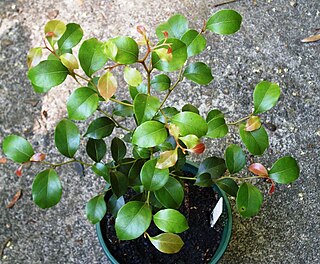
Cryptocarya williwilliana is a shrub or small rainforest tree and is commonly known as the small leaved laurel. It is confined to dry rainforest on steep rocky limestone slopes or at the base of limestone cliffs. It grows in remote areas at an altitude of 250 to 800 metres in the Macleay River valley near Kempsey, Australia. Maximum height is around 6 metres.
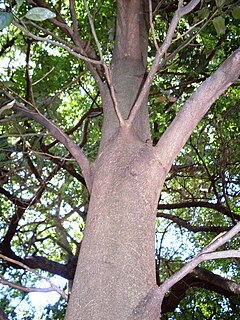
Cryptocarya foetida is a rainforest tree growing at the eastern coastal parts of Australia. The common name is due to the allegedly offensive odour given by the flowers. The stinking cryptocarya or stinking laurel is considered vulnerable to extinction with a ROTAP rating of 3VC.

Cryptocarya glaucescens, commonly known as jackwood, is a rainforest tree of the laurel family growing in eastern Australia.

Cryptocarya obovata is a large laurel growing on basaltic and fertile alluvial soils in eastern Australian rainforests. It is found from Wyong in New South Wales to Gympie in the state of Queensland. Extinct in the Illawarra region, allegedly seen in the Illawarra in 1818 by Allan Cunningham. The species was included in the Prodromus Florae Novae Hollandiae et Insulae Van Diemen, 402 (1810)

Cryptocarya laevigata, known as the glossy laurel or red-fruited laurel, is a rainforest plant growing in eastern Australia. The natural range of distribution is rainforest understorey on fertile soils, from the Richmond River, New South Wales to Cairns in tropical Queensland. Often seen in association with the White Booyong.

Cryptocarya foveolata, known as the mountain walnut is a rainforest tree growing at high altitude in eastern Australia. Despite the common name, it belongs to the laurel family.

Cryptocarya triplinervis is a rainforest tree growing in eastern Australia. Common names include the three veined laurel, three veined cryptocarya and the brown laurel.

Cryptocarya meissneriana, known as the thick-leaved laurel is a small tree growing in eastern Australia. The habitat is rainforest on the poorer sedimentary soils.

Ravensara is a genus of trees and shrubs of the family Lauraceae and endemic to the island of Madagascar and the Comoro Islands. The bark, leaves and fruit of the various species are rich in aromatic essential oils. In a recent generic classification of Lauraceae based on DNA sequence data by Chanderbali et al. in 2001, it was found to be part of a strongly supported clade that also includes Beilschmiedia, Potameia, Cryptocarya, Endiandra and Aspidostemon.

Cryptocarya bidwillii, the yellow laurel, is a small to medium-sized tree in the laurel family. Occurring in Australian rainforests from Nymboida in the state of New South Wales to Townsville in tropical Queensland. Often found in the dryer ridges in dry rainforest or in viney scrubs.
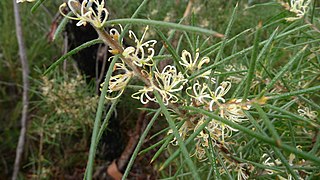
Hakea gibbosa, commonly known as hairy hakea or needlebush hakea, is a shrub of the family Proteaceae, and is endemic to south eastern Australia. It has very prickly foliage, cream-yellowish flowers from April to July, and provides shelter for small birds. It has become an environmental weed in South Africa and New Zealand, where it had been introduced for use as a hedge plant.
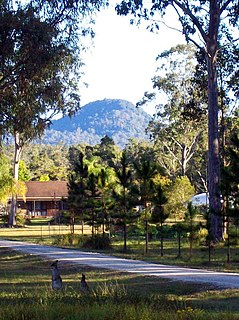
Cryptocarya floydii is an Australian rainforest tree. It occurs in steep dry rocky gullies in northern New South Wales and adjacent areas in Queensland as far north as Bunya Mountains National Park. It grows as far south as the upper gullies of the Guy Fawkes River and the Macleay River. The common name is gorge laurel or Glenugie laurel, after the type locality of Glenugie Peak, near Grafton, New South Wales.

Cryptocarya nova-anglica, the mountain laurel, is a rainforest tree growing in eastern Australia. The habitat is a restricted distribution in cool temperate rainforest mostly over 1,100 metres in altitude. The range of natural distribution is from the upper Hastings River to near the border of the state of Queensland. It is an understorey tree, associated with the Antarctic beech, possumwood, golden sassafras and black olive berry trees.
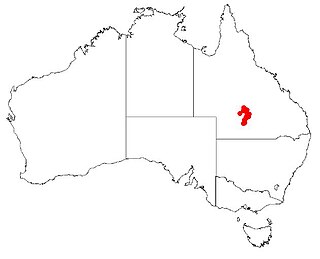
Hakea maconochieana is a shrub in the family Proteacea and is endemic to Queensland Australia. It is a rare species with red flowers, needle-like leaves and an upright or spreading shrub.

Hakea meisneriana is a shrub in the family Proteaceae and is endemic to Western Australia. It has small, nectar rich, creamy white flowers in clusters in the upper branches from August to November.
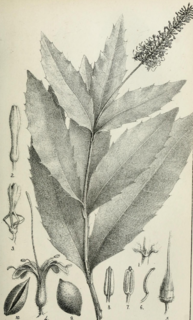
Macadamia ternifolia is a tree in the flowering plant family Proteaceae, native to Queensland in Australia, and is listed as vulnerable under the EPBC Act.

Hakea rostrata, common name beaked hakea, is a flowering plant in the family Proteaceae, native to South Australia and Victoria.



















